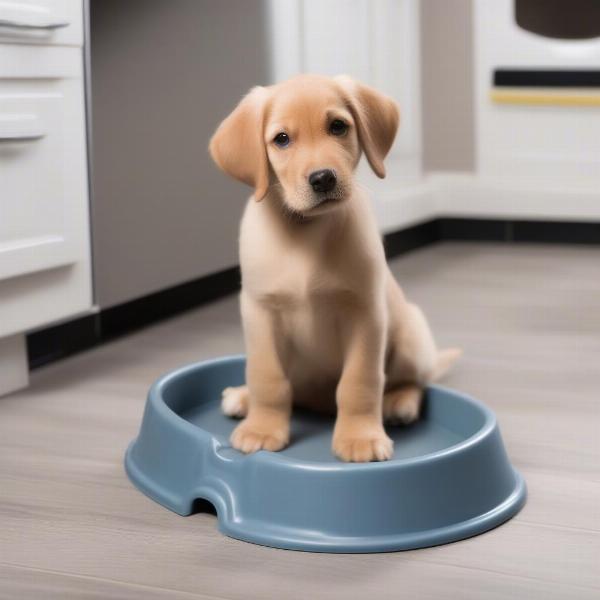Indoor dog potties are becoming an increasingly popular solution for pet owners living in apartments, high-rises, or facing mobility challenges. They provide a convenient and hygienic alternative to traditional outdoor potty breaks, especially during inclement weather or when time is limited. This guide explores everything you need to know about indoor dog potties, from choosing the right type to training your dog effectively.
Choosing the Right Indoor Dog Potty
The market offers a variety of indoor dog potty options, each with its advantages and disadvantages. Real grass patches deliver a natural feel and are often preferred by dogs, while synthetic grass pads are more durable and easier to clean. Absorbent pee pads are a disposable option suitable for small dogs or puppies, whereas litter boxes can be a good choice for cats and some small dog breeds. Consider your dog’s size, breed, and personal preferences when making your selection.
Training Your Dog to Use an Indoor Dog Potty
 Training a dog to use an indoor dog potty
Training a dog to use an indoor dog potty
Introducing your dog to an indoor dog potty requires patience and consistency. Start by placing the potty in a designated area and encouraging your dog to investigate it. Reward any interaction with the potty, even sniffing or pawing. When your dog successfully uses the potty, offer praise and a small treat. Consistency is key, so maintain a regular potty break schedule and clean the potty regularly to avoid accidents and maintain hygiene.
Maintaining Your Indoor Dog Potty
Regular cleaning is essential to keep your indoor dog potty hygienic and prevent odors. Depending on the type of potty you choose, this might involve rinsing synthetic grass, replacing real grass patches, or disposing of pee pads. For real and synthetic grass potties, ensure adequate drainage and ventilation to avoid mold and mildew growth. Regularly cleaning the area around the potty is also important for overall hygiene.
Benefits and Drawbacks of Indoor Dog Potties
Indoor dog potties offer numerous advantages, including convenience, particularly for those living in apartments or with mobility issues. They provide a cleaner solution compared to walking dogs on busy streets, and are helpful during bad weather. However, they also require an initial investment, consistent training, and regular cleaning. It’s important to weigh these factors against your individual needs and lifestyle.
Are Indoor Dog Potties Right for Your Dog?
Is your dog a senior struggling with mobility issues? Do you live in a high-rise apartment with limited access to outdoor spaces? An indoor dog potty could be the perfect solution. Consider your dog’s age, breed, temperament, and your living situation to determine if an indoor potty is the right fit.
Conclusion
Indoor dog potties offer a practical and convenient alternative to traditional potty breaks. Choosing the right type and implementing consistent training are key to successful integration. By understanding the benefits and drawbacks and considering your individual circumstances, you can decide if an indoor dog potty is the right choice for you and your furry friend.
FAQ
- How often should I clean my indoor dog potty? Cleaning frequency depends on the type of potty and your dog’s usage. Real grass patches may need replacing weekly, while synthetic grass should be rinsed daily. Pee pads should be disposed of after each use.
- What’s the best way to train my dog to use an indoor dog potty? Positive reinforcement, consistency, and patience are crucial. Reward successful potty breaks with treats and praise, and maintain a regular schedule.
- Are indoor dog potties suitable for all dog breeds? While most dogs can be trained to use an indoor potty, some breeds might adapt more easily than others. Consider your dog’s size and temperament.
- What are the different types of indoor dog potties available? Common types include real grass patches, synthetic grass pads, absorbent pee pads, and litter boxes.
- Where should I place my indoor dog potty? Choose a quiet, easily accessible location in your home.
- Are indoor dog potties expensive? The initial cost varies depending on the type of potty you choose. Consider long-term maintenance costs as well.
- Can I use an indoor dog potty for a puppy? Yes, indoor potties can be helpful for potty training puppies, especially in apartments.
ILM Dog is a leading international website dedicated to providing expert advice on all aspects of dog care and breeding. We offer valuable resources on dog breeds, health, training, nutrition, grooming, and much more. From puppy care to senior dog care, we cover everything you need to know to be a responsible and informed dog owner. For expert advice tailored to your needs, contact us at [email protected] or call us at +44 20-3965-8624. ILM Dog is here to help you provide the best possible care for your canine companion.